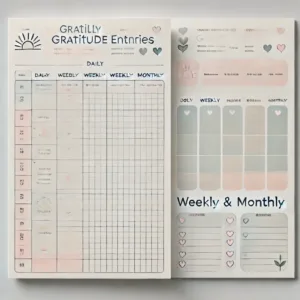Explore how to create a unique and engaging gratitude journal template that you can use every day
In This Post
Gratitude is a simple, yet powerful practice By taking a few moments each day to acknowledge what you’re grateful for, you can cultivate a more positive outlook on life.
One of the best ways to do this is through gratitude journal template, but let’s be honest—sometimes it’s hard to know where to start!
That’s where a gratitude journal template comes in handy. Having a structure to follow not only makes journaling easier but also ensures you’re getting the most out of the practice.
Whether you’re new to gratitude journaling or looking for fresh ideas to elevate your practice, this guide has something for you.
Why Start a Gratitude Journal?
Before we dive into the gratitude journal template ideas, let’s talk about the benefits of gratitude journaling. Research shows that practicing gratitude can reduce stress, improve sleep, boost self-esteem, and even increase happiness.
By reflecting on what you’re thankful for, you shift your focus away from negative thoughts and towards the positives in your life.
Now, let’s get into how to create a gratitude journal template that will keep you engaged and inspired.
Gratitude Journal Template Example
1. Themed Gratitude Sections
One way to make your Gratitude Journal Template more meaningful is by breaking it down into themes.
This helps you focus on different areas of your life, allowing for deeper reflection. Instead of listing random things you’re grateful for, why not organize them by category?
What specific things have they done to bring you joy or support?
Did you feel energized, strong, or peaceful?
Personal Growth:
How have you grown as a person lately? What new skills or traits are you proud of developing?
Career:
Reflect on your professional life. What opportunities, colleagues, or achievements are you thankful for?
It helps you explore different facets of your life, making your Gratitude Journal Template more well-rounded and insightful.
2. Daily, Weekly, and Monthly Check-Ins

Gratitude journaling isn’t just about reflecting on a single day. Over time, you’ll notice patterns in your gratitude practice, and having a structure to track these is key.
Consider breaking your gratitude journal template into daily, weekly, and monthly check-ins.
Daily:
A short and simple reflection on what you’re grateful for that day.
Weekly:
At the end of the week, review your daily entries and write about any major themes or lessons. What are you most thankful for over the past week?
Monthly:
Once a month, reflect on your overall mindset. How has your gratitude practice evolved? Are there areas of your life where you’re feeling more thankful than others?
This structure not only keeps you on track but also gives you the chance to look back and see how gratitude has shifted your outlook over time.
3. Gratitude Through the Senses
Instead of just writing about general events, focus on the sensations that bring you joy.
Sight:
What did you see today that made you feel thankful? Maybe a beautiful sunset, a smiling friend, or a peaceful moment at home.
Sound:
Did you hear a song that uplifted you, or perhaps a loved one’s laughter?
Touch:
What physical sensations brought comfort or joy today? A warm hug, soft blanket, or cool breeze?
Smell:
Reflect on the scents that bring you gratitude. The smell of coffee in the morning, a favorite candle, or the fresh air after a rainstorm
Taste:
What meal or drink made you feel thankful? It could be as simple as enjoying a good cup of tea or a delicious home-cooked meal.
By reflecting on gratitude through your senses, you’ll add another layer of mindfulness to your practice.
4. Gratitude Challenges
Sometimes a little challenge can help push your gratitude practice forward. Include some fun gratitude challenges in your gratitude journal template to keep things fresh. Here are some ideas:
The Two-Minute Challenge:
Write down five things you’re grateful for in under two minutes. This forces you to think quickly and spontaneously, capturing gratitude in the moment.
The Gratitude Swap:
Share one thing you appreciate about yourself with a friend or family member, and ask them to share something they’re thankful for too.
The “Thank You” Note Challenge:
Once a week, write a thank-you note (physical or digital) to someone who has made a difference in your life, no matter how small. Expressing gratitude outwardly can deepen your own sense of thankfulness.
These small challenges are great for keeping your practice lively and motivating you to think outside the box.
5. Visualization Space
Words are powerful, but sometimes a picture is worth a thousand of them.
Add a visualization space to your gratitude journal template, where you can either draw or paste images that represent what you’re thankful for.
Doodles and Sketches:

If you’re artistically inclined, use this space to draw something that reflects your Gratitude Journal Template. It doesn’t have to be a masterpiece—just a simple sketch of a flower, a smiley face, or something abstract can capture your feelings.
Collage:
Print out or cut pictures from magazines that represent the things you’re grateful for. You can create a collage of things that make you happy.
Mood Board:
Think of this space as a mini-vision board for gratitude. Use it to visualize the emotions, experiences, and people who bring you joy.
Incorporating visualization makes the gratitude journal template process more creative and can help you connect with your gratitude on a deeper level.
6. Gratitude and Future Vision
In addition to reflecting on the present, use your gratitude journal template to express gratitude for the future.
This technique involves writing as if the things you hope for have already happened, fostering a sense of optimism and manifestation.
“I am grateful for the exciting career opportunity that has come my way.”
“I am thankful for the strong, supportive relationships I continue to build.”
By practicing gratitude for future events or goals, you can set positive intentions and foster a sense of trust in the process of life.
7. Random Acts of Kindness Tracker
Gratitude and kindness go hand in hand. To enhance your gratitude practice, include a section in your Gratitude Journal Template to track both the random acts of kindness you perform and those you receive.
Kindness Given:
Reflect on any kind gestures you made that day or week. It could be something as small as holding the door for someone or as big as volunteering your time.
Kindness Received:
What moments of kindness did you experience today? Maybe a friend helped you with a task, or a stranger offered a compliment.
By tracking these acts of kindness, you’ll become more aware of the positivity that surrounds you, both from yourself and others.
8. Personal Growth Reflection
gratitude journal template isn’t just about celebrating the good—it’s also about reflecting on how challenges help you grow.
Add a section to your Gratitude Journal Template where you can write about moments of personal growth, even if they arose from difficult circumstances.
Some prompts
“What challenge am I grateful for today, and how has it made me stronger?”
“What lesson have I learned recently that I’m thankful for?”
“How has my gratitude practice helped me navigate tough times?”
By framing challenges as opportunities for growth, you’ll build resilience and appreciation for all of life’s experiences.
9. Quotes and Affirmations
Sometimes, we need a little extra inspiration to stay motivated in our gratitude practice. Including quotes and affirmations in your Gratitude Journal Template is a great way to keep your focus on positivity.
Each week or month, choose a new gratitude-related quote or affirmation to reflect on.
“Gratitude turns what we have into enough.”
“I am grateful for the abundance in my life.”
“Gratitude unlocks the fullness of life.
Writing down and reflecting on these quotes can reinforce your practice and provide a source of encouragement when you need it.
10. Nature Appreciation

In today’s fast-paced world, it’s easy to overlook the beauty of nature.
Including nature appreciation prompts in your Gratitude Journal Template can help you stay grounded and connected to the world around you.
Some prompts
“What natural beauty did I experience today?
“What aspect of nature am I most grateful for right now?”
Whether it’s the sound of birds in the morning, the warmth of the sun, or the calming presence of trees, nature offers countless reasons to feel gratitude.
11. Time Capsule of Gratitude
Looking back at how your gratitude has evolved can be incredibly rewarding. Consider adding a time capsule section to your gratitude journal template, where you can record your thoughts at certain milestones and revisit them later.
This allows you to reflect on your journey and recognize the growth
Current Reflection:
Write down your current state of mind, what you’re most grateful for, and any hopes or aspirations you have for the future.
Future Note:
Set a reminder for yourself to revisit this section in six months, a year, or another time period. When you come back to it, see how your mindset has changed, and reflect on the journey.
The time capsule serves as a way to track long-term changes in your gratitude practice and personal growth.
It’s a powerful tool for recognizing the positive shifts that may otherwise go unnoticed.
12. Seasonal Gratitude Prompts
By incorporating seasonal gratitude prompts, you can reflect on what each time of year brings and the unique experiences it offers.
Spring:
“What new beginnings am I grateful for?” or “How has the renewal of nature inspired gratitude?”
Summer:
“What outdoor experiences brought me joy this summer?” or “How has the warmth of the season made me appreciate life?”
“What lessons am I thankful for as the year winds down?”
Winter:
“How has the coziness of winter helped me reflect inward?” or “What relationships and connections have kept me warm during these colder months?”
These prompts help you stay connected with nature’s rhythms and deepen your appreciation for the cyclical nature of life.
13. Gratitude Map
This involves mapping out locations where you’ve experienced moments of gratitude, linking places to positive memories and experiences.
1.You can either create a digital map or draw one in your gratitude journal template.
2.Think about places where significant moments of gratitude occurred—your favorite coffee shop, a park where you walk your dog, or a family member’s house.
3.Alongside each location, jot down a short note about what you experienced there and why it made you feel thankful.
This technique helps you see the world around you through a lens of gratitude, linking physical spaces with positive emotions.
14. Gratitude Habit Tracker
By tracking your gratitude practice, you can build consistency and make it a regular part of your life.
Daily Tracking:
Include a simple grid or calendar where you can mark off the days you practice gratitude. Whether it’s writing in your gratitude journal template or simply taking a mental note, this helps you stay accountable.
Weekly Review:
At the end of each week, review your practice. How many days did you actively focus on gratitude? Were there any patterns or days where it was harder to find things to be grateful for?
Set Goals
If you’re aiming to practice gratitude daily, set a goal and track your progress. Over time, this habit will become second nature, and the tracker can serve as a visual reminder of your commitment.
This structured approach not only reinforces the habit but also allows you to reflect on the impact it’s having on your life.
15. Gratitude for Challenges
While it may seem counterintuitive, expressing gratitude for difficulties can help you develop resilience and a growth mindset.
Add a section in your gratitude journal template to specifically reflect on challenges.
“How has a recent difficulty helped me grow?”
“What life lesson have I learned through adversity?”
By actively acknowledging the positive outcomes of difficult experiences, you shift your perspective from one of frustration to one of appreciation.
16. Daily Gratitude Mantra
Mantras can be a powerful tool for positive thinking, and incorporating them into your gratitude journal can help you stay focused on the present moment.
Consider adding a space for a daily gratitude mantra that you can either create yourself or choose from a collection.
Based on your journal entry for the day, craft a short, positive mantra to carry with you throughout the day.
You can also include a list of pre-written mantras or affirmations that readers can select from, such as
“I attract abundance and positivity” or “Today, I focus on gratitude and contentment.”
Writing and repeating a daily mantra helps solidify your gratitude practice and gives you something to focus on during moments of stress or distraction.
17. Gratitude for Others
Gratitude isn’t just about being thankful for things in your own life—it’s also about appreciating the people around you.
Add a section in your gratitude journal template specifically dedicated to gratitude for others.
Once a week, take a moment to write a short thank-you note to someone who has made a difference in your life.
List three positive things about someone you interacted with today. This helps foster appreciation for the people in your life and shifts your mindset toward kindness.
Your gratitude practice becomes not only about personal reflection but also about connecting with others.
19. Mindful Moment of the Day

To integrate mindfulness into your gratitude practice, include a section for a mindful moment of the day.
This is where you can reflect on a moment that brought you fully into the present.
At the end of each day, write about a single moment when you felt completely present. It could be while enjoying a meal, walking in nature, or simply taking a deep breath.
Reflect on how that mindful moment helped you feel grateful. Did it calm your mind? Make you appreciate something you hadn’t noticed before?
This practice helps you slow down and notice the small moments in life that often go unnoticed, cultivating a deeper sense of gratitude.
20. Color-Coded Gratitude

If you’re a visual person, consider color-coding your gratitude journal template entries to reflect different aspects of your life.
This technique adds a layer of creativity and allows you to easily identify patterns in your gratitude practice.
Assign different colors to categories like relationships, health, work, and personal growth.
As you journal, highlight or write your entries in the corresponding color. For example, use red for relationship-related gratitude and green for nature-based appreciation.
Over time, you’ll be able to see which areas of your life you’re focusing on most and which may need more attention.
Color-coding adds a fun and engaging element to your journal while helping you maintain balance in your reflections.
Conclusion
Creating a gratitude journal template doesn’t have to be complicated.
With these 20 unique and engaging ideas, you can design a journal that’s not only effective but also inspiring and fun to use.
Whether you’re just starting out with gratitude journaling or you’re looking to elevate your practice, these ideas will help you dive deeper into mindfulness, appreciation, and personal growth.
By incorporating sections like themed gratitude, daily check-ins, sensory reflections, and even creative challenges, your journal will become a tool for cultivating positivity and resilience.
Remember, gratitude is a practice that grows over time, and the more you engage with it, the more you’ll feel its impact on your life.
Happy journaling!



